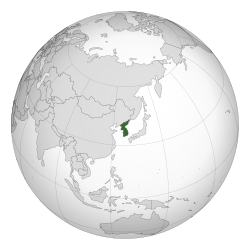Joseon
Joseon | |||||||||
|---|---|---|---|---|---|---|---|---|---|
| 1392–1897 | |||||||||
 Territory of Joseon after Jurchen conquest of King Sejong | |||||||||
| Capital | Hanseong[a] | ||||||||
| Common languages | Korean | ||||||||
| Common script | Classical Chinese, Korean | ||||||||
| Religion | Confucianism (state ideology) Buddhism Shamanism Taoism Christianity (recognized in 1886) | ||||||||
| Government | Absolute monarchy[2] | ||||||||
| King | |||||||||
• 1392–1398 (first) | Taejo | ||||||||
• 1863–1897 (last) | Gojong | ||||||||
| Yeonguijeong, later Prime Minister[b] | |||||||||
• 1392–1398 (first) | Jeong Do-jeon | ||||||||
• 1896–1898 (last) | Yun Yong Seon | ||||||||
| History | |||||||||
• Coronation of Taejo | 5 August 1392 | ||||||||
| 9 October 1446 | |||||||||
| 1592–1598 | |||||||||
• First and second Manchu invasions | 1627, 1636–1637 | ||||||||
| 26 February 1876 | |||||||||
| 17 April 1895 | |||||||||
| 13 October 1897 | |||||||||
| Population | |||||||||
• 1400[3] | 5,730,000 | ||||||||
• 1500[4] | 9,000,000 | ||||||||
• 1600[4] | 11,000,000 | ||||||||
• 1700[4] | 13,500,000 | ||||||||
• 1900[3] | 17,082,000 | ||||||||
| Currency | Mun (1423–1425, 1625–1892) Yang (1892–1897) | ||||||||
| |||||||||
| Today part of | North Korea South Korea | ||||||||
| Korean name | |
| Hangul | |
|---|---|
| Hanja | |
| Revised Romanization | Joseon |
| McCune–Reischauer | Chosŏn |
| IPA | [tɕo.sʌn] |
| North Korea name | |
| Hangul | |
| Hanja | |
| Revised Romanization | Joseon Bonggeon Wangjo |
| McCune–Reischauer | Chosŏn Bonggŏnwangjo |
| Official name | |
| Hangul | |
| Hanja | |
| Revised Romanization | Daejoseonguk |
| McCune–Reischauer | Taechosŏnguk |
| IPA | [tɛ.tɕo.sʌn.ɡuk̚] |
Joseon (Hangul: 조선; Hanja: 朝鮮; also Chosŏn, Choson, Chosun, Cho-sen), was a Korean state started by Taejo Yi Seong-gye. It began after the end of the Goryeo Dynasty at what is today the city of Kaesong. It ended with the assassination of Empress Myeongseong. Joseon was the last dynasty of Korean history and the longest Confucian dynasty.
Today, some Koreans use the word "Joseon" to mean something bad because they think of the Joseon Dynasty as something that failed. Young Koreans use the expression "Hell Joseon" to talk about how hard it is to find a good job in South Korea today.[7]
History[change | change source]
Major events[change | change source]
The creation of Hangul[8][change | change source]
Hangul is the language of Korea that is still used today.
Hangul was created by King Sejong the Great in 1443 and officially put into effect nationwide in 1446. It was created based on the shape of the human vocal apparatus when pronouncing it.[9] The creation of Hangul had many good influences, including the creation of culture.
Japanese Invasion (Imjin War)[change | change source]
The Japanese Invasion was a war between Joseon and Japan from 1592 to 1598 (7 years). Toyotomi Hideyoshi of Japan invaded Joseon after unifying his country. Then king, Seonjo, fled to the north. But as the Joseon's army, including Yi Sun-sin, fought hard, Japan retreated for a while. Japan invaded again in 1597,[10] and the war ended when Toyotomi Hideyoshi died.
During the war, many cultural assets of Joseon were destroyed and taken away.[11]
Qing invasion[change | change source]
The Qing invasion was a war fought between the Joseon Dynasty and the Qing Dynasty from 1636 to 1637. Joseon fought to protect the country, but Joseon was eventually defeated by the Qing Dynasty. Injo surrendered to the Qing Dynasty.
At this time, many Qing soldiers kidnapped Joseon women to make concubine or sell them.[12] Including this, a lot of social damage had occurred to Joseon because of this invasion.
Notes[change | change source]
- ↑ Now Seoul, South Korea.
- ↑ Style: Yeonguijeong (1401-1894); Naegak chongri daesin (1894-96); Ui jeong (1896-1905)
References[change | change source]
- ↑ Li, Jun-gyu (이준규) (2009-07-22). (세상사는 이야기) 왜색에 물든 우리말-(10) (in Korean). Newstown.
1392년부터 1910년까지 한반도전역을 통치하였던 조선(朝鮮)은 일반적으로 조선왕조(朝鮮王朝)라 칭하였으며, 어보(御寶), 국서(國書)등에도 대조선국(大朝鮮國)이라는 명칭을 사용하였었다. (translation) Joseon which had ruled from 1392 to 1910 was commonly referred to as the "Joseon dynasty" while "Great Joseon State" was used in the royal seal, national documents, and others.
[permanent dead link] - ↑ Choi, Sang-hun (27 October 2017). Interior Space and Furniture of Joseon Upper-class Houses. Ewha Womans University Press. p. 16. ISBN 9788973007202 – via Google Books.
Joseon was an absolute monarchy
- ↑ 3.0 3.1 권태환 신용하 (1977). 조선왕조시대 인구추정에 관한 일시론.
- ↑ 4.0 4.1 4.2 이헌창 (1999). 한국경제통사 52쪽.
- ↑ "조선력사 시대구분표". Naenara (in Korean). Archived from the original on 2019-07-01. Retrieved 1 July 2019.
- ↑ "Korean History in Chronological Order". Naenara. Archived from the original on 2019-07-01. Retrieved 1 July 2019.
- ↑ Mike Williams. "A hope in hell: Why do young people in South Korea refer to their country as hell? The answer depends on who you ask". ABC. Retrieved August 16, 2020.
- ↑ It is sometimes written as 'Hangul' based on English, but it is also correct to write 'Hangeul' according to the Romanization system.[1] Archived 2022-10-12 at the Wayback Machine
- ↑ Service (KOCIS), Korean Culture and Information. "Joseon Dynasty : Korea.net : The official website of the Republic of Korea". www.korea.net. Retrieved 2022-10-12.
- ↑ This war is called 'Jeong Yoo Jae-ran(Korean : 정유재란).
- ↑ "Korea Information - History". Korean Cultural Center New York. Retrieved 2022-10-12.
- ↑ "The tragic fate of Joseon women". koreajoongangdaily.joins.com. 2010-12-29. Retrieved 2022-10-12.




